New Construction Inspection
Here is a breakdown of the different areas of the home that will need to be accurately inspected by one of our new construction home inspection experts.
Footers and Foundation
New construction home inspection for footers and foundations
New Foundation Inspection
A solid home begins with a properly designed and built foundation. Any problems with the foundation will undermine the integrity of the entire home and lead to major problems. While a foundation may appear like a simple structure, it actually relies on complex engineering. There are a variety of essential components that combine to provide the perfect strength and stability to suitably support a home for years to come. An inspector will be able to identify any potential complications and help buyers and sellers avoid expensive repairs.
Foundation Structure
When it comes to verifying the integrity of a foundation, an inspector will look at several construction factors, including:
- Have the footers been placed at the proper depth?
- Are the footers located within the appropriate distance from the foundation walls?
- Are the walls precisely centered on the footers?
- Have the foundation walls been constructed using the optimal materials?
- Are the foundation walls the right thickness to handle existing soil conditions?
- Have the concrete reinforcements been properly installed?
- Have anchor bolts been used when necessary and properly installed?
- Foundation standards vary according to different climates and soil conditions. This is why it is important to work with an inspector who is familiar with the Central Ohio area.
Waterproofing
Moisture is the number one enemy of a foundation, which is why inspectors pay close attention to waterproofing. A residential foundation should include an application of cement and also an additional layer of a bituminous material or other waterproofing membrane. These measures are especially important in areas where a combination of factors create a high risk for water to come into contact with the foundation. The inspector will make sure the right protections are in place and confirm there aren’t any existing signs of water damage before approving the foundation.
Venting
The International Residential Code has clear standards for installing vents in a foundation. For example, the code dictates that for every 150 square feet of space, a one square foot vent must be installed. In addition, a vent must be placed within three feet of every corner. An inspector will ensure both of these requirements are being met so air can flow through the home and help combat moisture and other ventilation related problems.
Cracks and Signs of Foundation Movement
If there is damage to the foundation or there has been significant movement, the signs can be fairly clear and visible. Not only will cracks appear in the actual foundation and exterior masonry, there will also be cracks throughout the interior of the home. An inspector will look for any cracks above doors and windows and across the ceiling. Buckled floors, loose moldings and doors that no longer open and close properly are also signs that the foundation has experienced too much movement and may be susceptible to additional problems. A seasoned inspector will go beyond examining exterior cracks and be able to determine whether cracks are a symptom of normal settling or a sign of a larger issue that should be addressed immediately.
Lot Grading and Drainage
Protecting a home’s foundation from moisture begins with proper grading and drainage. Every effort should be made to ensure water is directed away from the home and is not able to pool around the foundation. This can mean changing the topography of the surrounding land to create slopes that direct water away from the home. The solution can be as simple as forming a swale, or shallow ditch next to the foundation walls in order to control the flow of water.
It is also important to install gutters and downspouts around the exterior of the roof. These simple devices will collect rainwater and make sure that it is directed a safe distance away from the house. Without these additions, rainwater will simply run off the edge of the roof and pool at the foundation.
While it is impossible to prevent any moisture from reaching the foundation, it is important to take the necessary steps to reduce risk as much as possible. Poor lot grading and drainage can cause wood damage, which can create the perfect environment for insect infestations and saturated soil that will shift the entire home. Taking precautionary steps during the construction process can protect the integrity of the home and prevent damage to the foundation.
As a general rule, any land that is adjacent to the foundation walls must have a certain slope. In Ohio, the standard is a slope rate of one inch per foot for a total length of at least six feet. This is enough to adequately direct water away from the home and is a major item on the checklist of our inspectors. If this level of slope doesn’t naturally occur, then gravel and soil needs to be added. While this might sound like a hassle, adding a little dirt is much easier than dealing with a water-logged home and crumbling foundation down the road.
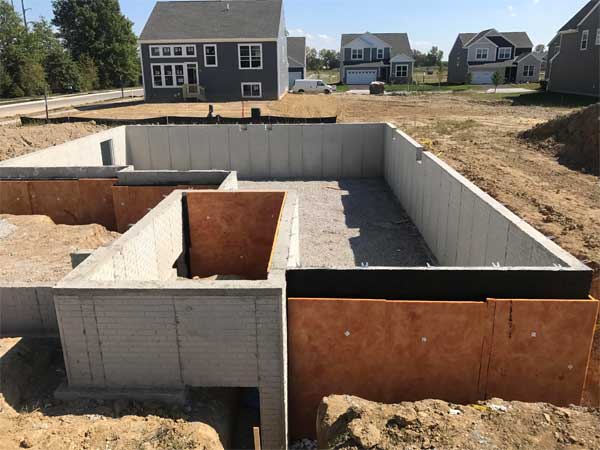
Foundation inspection in Columbus Ohio. Schedule an appointment for a new construction inspection now.
Framing
We inspect house frames with our new construction inspection.
Wood Framing
Once the lot has been appropriately graded and the foundation has been poured, it is time to start framing the house. This is when the structure really starts to take shape and it becomes easier to visualize the final product. Framing represents a critical stage of the building process. If the walls and floors are incorrectly erected and not plumb, then the rest of the house will be off balance. From there, all of the finishing touches, such as flooring, drywall and even doors won’t look and operate correctly. Just a few measuring and installation mistakes during the framing process can be enough to throw everything off.
The first step in framing a house is to lay floor joists and attach them to the foundation. Anchor bolts and tie down straps are used to secure the wood joists to the foundation. Once the joists are in place, the entire area is covered with subfloor, which usually consists of ¾ inch plywood or OSB (orients stand board). Either nails or screws, along with glue, are used to secure the subflooring in place to prevent any squeaking.
Next, the rough framing of the walls needs to be completed. The walls are constructed using 2X4 studs and provide room and support for different openings, such as doors and windows. Top and bottom plates, headers, king studs and cripples are also incorporated to provide adequate support and places to anchor wall coverings.
Once the walls have been framed and secured to the floor they form the general outline of the home, then trusses can be raised. In the past, trusses were built entirely out of wood, but modern versions incorporate composite materials that are environmentally friendly and provide a lighter and stronger final product. This is important considering that the trusses are responsible for carrying the weight load of the roof.
After all the framing has been completed, the walls will be covered with drywall that will provide a smooth surface that can be painted and finished according to the buyer’s personal style preferences. The exterior of the walls will be covered in plywood sheathing, which will then be covered in brick, siding, cedar shingles, stucco or whatever final building material chosen to decorate the outside of the home.
Your inspector will examine the entire framing process and make sure that each step is completed according to industry standard. Home Inspections LLC will provide the necessary checks and balances and make any recommendations for improvements if necessary.
The Roof
The roof is the final touch on the framing process. While the trusses can be built on site, this job is often outsourced to a company that can build pre-manufactured trusses and deliver them to the location where a crane can easily hoist heavy trusses on to the walls. Opting for off-site construction makes it easy to build trusses that can fit practically any property. Most home inspectors will confirm the truss engineering calculations during the framing inspection and ensure that it is capable to carrying dead and live loads, including heavy snow loads that are common in Columbus, Ohio.
Builders may choose to attach a stick built roof because this design provides more flexibility and will allow the buyer to make better use of the attic space. As a general rule, the materials used to construct a stick roof tend to be cheaper than a pre-manufactured option, but builders and buyers can expect to pay more in labor, ultimately making it the more expensive and time consuming option.
City Framing Inspection
Once the framing has been completed, the city will require that an inspector visit the site and checks to make sure that all building codes have been followed and adhered to during the construction process. As a buyer, it is also important to remember that it is not the responsibility of the inspector to verify the quality of work. While framing the house may have taken weeks, the inspector will only spend a about an hour conducting their work, so they need to prioritize code issues. At the top of the list will be fire blocking. You may want to discuss this issue with your framing contractor before they are even hired to make sure they are aware of current codes and will avoid any complications.
The top 10 list of common framing errors includes:
- Incorrect sheathing span. APA rated sheathing panels are marked with two numbers. Typical markings include: 32/16 and 48/24, etc. The first number indicates the maximum number of inches between supports. Sheathing requires two to three supports in order to be properly installed. If there aren’t enough supports per sheathing span, then the inspector will require corrections.
- Sheathing is installed in the wrong direction. Sheathing comes with what is known as a strength axis, which runs parallel with the grain and usually corresponds with the long dimension of the board. Proper installation requires that the strength axis runs perpendicular to the wall studs to provide maximum strength.
- Narrow and improperly installed sheathing panels. If a panel is cut to a width of less than 24 inches, the panels will need to be reinforced with proper supports in order to handle loads. These smaller panels are typically installed in roof ridges and provide workers a place to safely walk while they are completing construction. Blocking and support clips must be added to these panels to meet safety standards.
- Glulam beams are installed upside down. Glulam or glued laminated timber beams are specially constructed with specific compression and tensions zones. For these zones to bend to stresses as needed, the beam must be installed in the right direction. The word “top” is usually stamped in the beam to help with installation, but there are still instances where the beams are installed upside down and will need to be amended.
- Panels are not spaced correctly. Wood and composite panels will naturally expand and contract as the weather and moisture levels change. If panels are placed directly next to one another without adequate spacing, then the panels will buckle and cause additional problems. An inspector will make sure that there is 1/8 inch or space between panels to allow for safe expansion.
- Improper fastening. You might be surprised to learn just how important it is to use the correct type of fastener while also making sure they are correctly located and spaced. Overdriving fasteners or using the wrong size to secure panels to the frame can result in both structural and aesthetic problems.
- Poor joist spacing. Inconsistent spacing between joists can create a noticeable difference in the way the floor feels in certain places. If an inspector doesn’t flag this issue, buyers may voice their concerns and request corrections down the road.
- Inadequate floor glue. When a floor has been consistently glued and secured with fasteners, it will create a solid structure. Any inconsistencies can create squeaky floors and unhappy buyers.
- Inadequate moisture barriers and water management efforts. Diverting water away from the home and incorporating the proper elements to allow for moisture to quickly dry, are essential steps to protecting the integrity of a home. An experienced professional will make sure that these protections are in place before additional work is done to the home.
- Improperly placed holes and notches. Various notches and holes will need to be made in the frame of the home plumbing and electrical to be installed. However, inspectors must pay close attention to placement so that the structural integrity of the home isn’t affected.
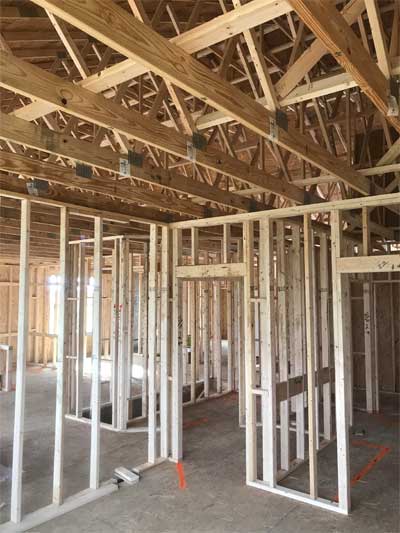
Framework inspection in Columbus Ohio. Schedule an appointment for a new construction inspection now.
Roofing
Roofing New Construction Inspection
On the most basic level, the roof is responsible for protecting the home from wind and rain. However, a properly installed roof creates a proper airflow that allows for ventilation and prevents condensation. Moist air has a tendency to accumulate in the attic, but a well-constructed roof will allow this moisture to escape. If condensation continues to build, rot can occur and the entire integrity of the home can be compromised. The roof serves as an essential component of the home that allows it to “breathe” and expel moisture. An inspection will look for a variety of signs that a roof will function effectively.
Roof Inspection Checklist
External Inspection
To get a good view of the roof, an inspector will either use a ladder to get a closer look or use a drone to survey the area. As they are conducting their inspection, here is what they are looking for:
- Blistered, curled, or split shingles. A few problem spots can be easily patched and spot repaired, but too many damaged shingles may be a sign that it is time to replace the entire roof.
- Loose or missing shingles. Again, these areas can usually be easily fixed, but may also be a sign of poor installation practices that could mean larger underlying obstacles. This problem is especially common where roof ridges and hips meet.
- Exposed nails. Even a loose nail that is rising from the surface of the roof provides enough space to cause a leak that can result in water damage.
- Dark patches. Asphalt roofs, which are quite common in the Columbus, Ohio, area will form dark patches where the granules have worn away.
- Asphalt granules in the gutter. It is normal for some of the asphalt granules to become loose and be washed off the roof into the gutters. However, a combination of dark patches and accumulating granules can be a clear sign that the roof is well past its prime and ready to be replaced.
- Sagging. Roofs tend to sag in the middle and along ridges as they age. A simple visual inspection should be enough to detect any signs that the roof is no longer level.
- Rusty shingles and flashing along roof joints. Chimneys, plumbing vents and other areas where vertical additions meet the roof should be surrounded in flashing that protects these vulnerable joints and diverts water. Any signs of rust or damage to these areas could mean water is penetrating the joint and repairs should be made.
- Damaged flashing around plumbing vents and chimneys. Loose shingles or rusty, loose flashing is another sign of trouble. Step flashing around chimneys must be well embedded in the mortar between bricks.
- Sagging gutters. The gutters are an important aspect of the roof and should be part of the inspection process. Sagging gutters, loose joints and damaged downspouts can allow water to accumulate around the foundation and cause structural damage.
Internal Inspection
- Any signs of leaks in the attic. An inspector will take a close look at the rafters and the roof decking to see if there are any darks spots that could indicate that water has entered through the roof. Other vulnerable areas that should be visually inspected include seams and joints around pipes, valleys, chimneys and skylights.
- Soft spots and rot. If an inspector does find a suspicious dark spot, they will test to see if any rot damage as occurred. Typically, pushing a screwdriver into the wood to see if it is soft can simply do this.
- Light coming through the roof. Certain roofs tend to let light in during the summer months, but this can also be a clear sign that repairs are necessary. Sagging sheathing. Sagging can be apparent during an external inspection, but more subtle signs of sagging can also be apparent if the sheathing is sagging between the rafters in the attic.
Flat roof:
Flat roofs come with their own set of challenges that our inspectors are aware of and look for during their visit.
- Blisters forming on the roof. Flat roofs are typically sealed with an asphalt coating. This material can blister and once the blister breaks, water may be able to enter and affect structural areas of the property. Our inspector will recommend contacting a roofing specialist for repairs before they become problematic.
- Depressions around joints and pipes. Low spots have a tendency of forming around vent pipes and other joints. This allows water to collect and eventually start leaking into the roof. These spots can be evened out with roofing cement. Check all flashing for any separations by the parapet that rings the flat roof.
- Clogged drains. Any obstructions in the drains that are placed at the low level of the roof will prevent water from running off the roof.
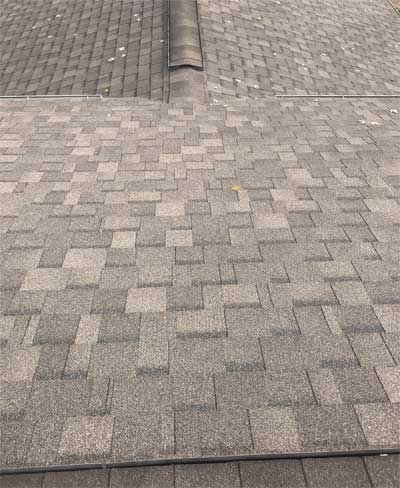
Roof inspection in Columbus Ohio. Schedule an appointment for a new construction inspection now.
Windows and Doors
Windows and Doors New Construction Inspection
Any openings, including windows and doors provide another opportunity for moisture to enter the home. Installing flashing, which is a water-resistant product that eliminates the gaps around openings can prevent water and moisture from damaging the home and causing poor air quality. It is important to keep in mind that each window manufacturer will provide their own set of requirements for flashing installation methods.
In general, there are two main elements in effectively installing flashing so water is sent down the exterior wall and away from the foundation. First, the flashing should be installed in conjunction with a water-resistant barrier (WRB) or house wrap that will cover the exterior sheathing. Second, the WRB should be installed in layers with the top layer overlapping the bottom; otherwise the water will be allowed to seep in behind the barrier.
Once the WRB has been installed, the type of flashing used at each opening will depend on both the type of window or door and recommendations from the manufacturer. When it comes to windows, there are both flanged and non-flanged flashing options depending on the style of the window. Jamb and head flashing should be used around the sides and top of any opening. An experienced builder will also take care to place sill or pan flashing at the base of openings so that water drains out of the home.
Even decorative details, such as molding, can influence what type of flashing is used. A final consideration is whether the windows and/or doors were installed before or after the WRB. All of these details can affect whether your home is protected from moisture. That is why it is important to work with an experienced builder and certified inspector in your area.
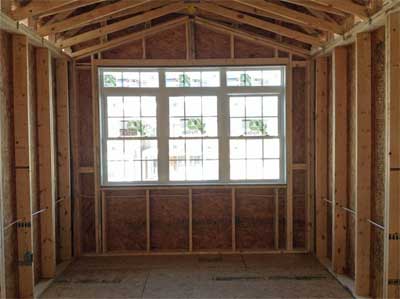
New window inspection in Columbus Ohio. Schedule an appointment for a new construction inspection now.
Insulation
Insulation New Construction Inspection
You might be surprised to learn that even home insulation is examined during the construction process. Inspectors will want to see that energy conservation standard has been met and that there is enough insulation to prevent condensation. This part of the inspection must be completed before any interior finishes are installed so that the inspector has easy access and can identify any problems.
During this process, the inspector will pay close attention to the following areas:
- The amount and location of insulation
- The presence of necessary vapor barriers
- The quality of air barrier systems
- Minimal thermal resistance or the ability for heat to properly transfer
- If all the necessary insulation requirements have been met, the builders can proceed with installing interior walls and other finishing touches.
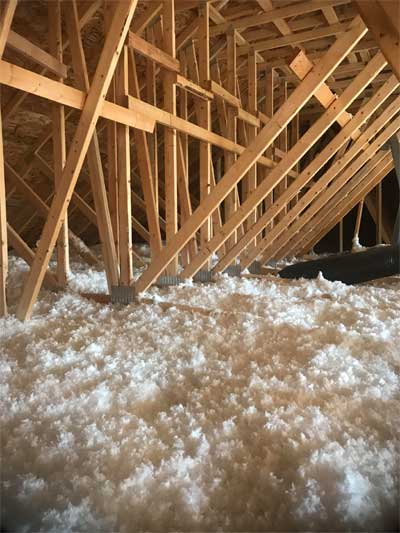
Insulation inspection in Columbus Ohio. Schedule an appointment for a new construction inspection now.
Electrical Inspections
Electrical New Construction Inspections
Properly installed electrical wiring is about much more than convenience. Poor workmanship can cause safety issues and put buyers at risk for electrical fires and other hazards. It is vital that inspectors and builders work together to make sure that every component of a home’s electrical system is compliant with residential building standards. Here are some of the main elements that will be examined during the electrical inspection:
- Is the electrical system large enough to supply the property and still allow for additional loads if the buyers decide to expand?
- Is the wiring properly grounded and operating properly?
- Have the right switches and outlets been installed throughout the home?
- Are areas that can get damp, such as kitchens, bathrooms, basements and garages, properly equipped with ground fault circuit interrupters (GFCI) outlets?
- Are there enough outlets in each room to accommodate electrical needs?
If you are interested in purchasing an existing home, then there are some other considerations that an inspector will need to take into account. The last thing you want to do is purchase a home with an outdated wiring system and find out that it will cost you thousands of dollars to complete the necessary upgrades. In older homes, inspectors will check for aluminum wiring, which will need to be replaced.
A thorough inspection can also involve a service panel checklist examination. While this can be a time-consuming project, it will reveal exactly how the existing electrical system works and whether the previous owner has overloaded any of the circuits. This can provide vital information that will allow you to negotiate the sale price of the home and help you avoid major headaches down the road.
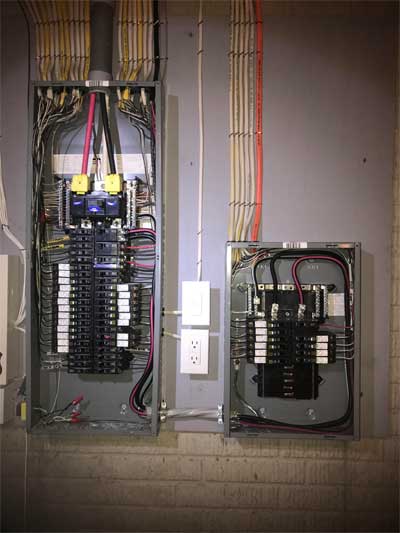
Electrical inspection in Columbus Ohio. Schedule an appointment for a new construction inspection now.
Plumbing Inspections
Plumbing New Construction Inspection
The plumbing system is another important component of any home that will require the attention of an experienced inspector. Every aspect of the plumbing system, from faucets to the water meter, should be examined and checked for any signs of damage. Here are a few areas that should be covered during the inspection:
- Water meter: An older meter may need to be replaced in order to correct leaks that can run up your water bill and cause sink holes in your yard. Shutting off the water and taking a close look at the connections for signs of water can easily detect leaks.
- Service line: The pipe that transports water from your house to the meter is known as the service line. Any line that is more than 35 years old will most likely need replacing, which can be a major expense. It is important to determine the age of the service line and check for any leaks.
- Service entrance: Another common area for leaks is the service entrance, which is where the line enters your home. This is also where the shut off valve is located. The valve should be checked to ensure it is working and completely stops the flow of water to the home. If this component is not working, you could experience flood damage if a plumbing problem arises and the water cannot be shut off.
- Water heater: Again, it is important to check all connections for leaks and make sure the pipes don’t show any signs of rust or corrosion. A simple visual inspection of the heater should be enough to identify whether there are any water stains or leaks, which would indicate the water heater is failing.
Kitchen Plumbing
Once the major components of the water system have been inspected, it is time to move onto the faucets, drains and interior plumbing throughout the home.
Both the kitchen and bathroom faucets should be inspected for signs of leaks or corrosion. The water should easily flow through the faucet and it shouldn’t take too long for the hot water to reach the faucet. If any of these functions are slow, then the pipe and/or faucets may be full of sediment and mineral deposits. Not only can this affect how well your plumbing operates, it can also increase your water and energy bills.
Next, the connections and shut off valves located in the cabinets under sinks should be inspected. Again, any signs of leaks, corrosion or water stains could mean a larger problem that needs to be addressed. It is especially important to take a close look at the supply lines. A faulty supply line will burst late at night when water pressure is at its highest and can be enough to flood an entire home.
While it is important to make sure water is easily making it to the home, it is equally important water is being properly drained. A slow drain may be the result of an isolated clog, but it could also be a sign of a larger problem with the sewer system. Tree roots can actually penetrate the sewer pipes and require expensive repairs. An experienced inspector or plumber will be able to use cameras to look inside the sewer system and identify any major problems with the main lines.
Bathroom
The bathroom toilet can also be a source of water problems. It is important the toilet bowl clears completely and quickly fills back up. If the water continues to run, then there may be a problem with the flapper valve. While this is a relatively easy fix, left unaddressed, it could result in high water bills.
Laundry
The laundry room is another area of the home where proper plumbing is important. All the water hoses should be dry and free of any cracks or signs of damage. If rubber hoses are being used to feed and drain water from the washer, then an inspector may recommend they be replaced with stainless steel products that come with a longer lifespan and a decreased chance of breaking and flooding the home. As with other plumbing connections, it is also important to make sure that all the pipes and hoses in the laundry room are properly secured and free of any clogs that can decrease efficiency.
The Basement
Most houses in Central, Ohio have a basement, which houses much of the home’s plumbing system. The experts at Home Inspections LLC will take the time to thoroughly check all the pipes and water lines to detect signs of leaks, corrosion or damage. This important step can identify small leaks before they become larger problems and protect buyers.
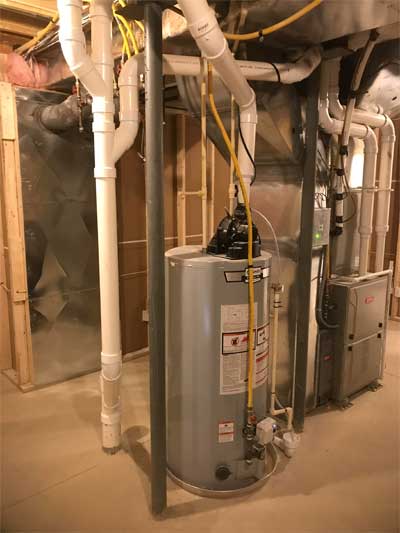
Plumbing inspection in Columbus Ohio. Schedule an appointment for a new construction inspection now.
HVAC Inspections
HVAC New Construction Inspection
The heating ventilating and air conditioning (HVAC) system performs a complicated series of tasks that keeps air flowing through the home and helps keep the indoors at a comfortable temperature, year-round. It is the job of our home inspectors to make sure that every component of the system is working and to make sure the buyer understands the capabilities and limitations of their system. For example, some finished basements are not serviced by the HVAC system and this may be something the buyer will want to address or upgrade.
One of the first aspects of the HVAC system that an inspector will look at is the placement of air handling units. Larger homes may come equipped with more than one unit and these are typically located in attics, basements, garages, and closets and even outside of the home. The location of the units can affect installation methods and how air is pushed through to the different areas of the home. Units will be set up differently based on a variety of factors and it is important for inspectors to have a deep knowledge of all the different aspects that can affect operations.
Central, Ohio is known for it’s cold winters, which can make it hard for furnaces to keep up with low temperatures and high winds. Homes that use a thermostat and heat pump will also have an emergency heat setting that will provide additional heat on extremely cold days. This is another aspect of the HVAC system and our inspector’s are familiar and able understand in order to identify potential setbacks.
Different furnaces will also rely on different types of fuel. Older homes may still count on heating oil or kerosene although most homes now use natural gas, propane gas or electricity to generate heat. Any leaks can cause safety issues, making it especially important to partner with certified inspection professionals who are familiar with residential building codes and standards.
The HVAC system relies on a series of ducts to move conditioned air from the handler throughout the home. Problems with the ducts are common and these components should be inspected in order to help identify any leaks. Ideally, the home’s air will be sent back to the handler through the return ducts, however duct damage can allow ambient air to be drawn into the system. While this might not seem like a problem, if the furnace is located in a damp basement or area that has mold or asbestos. Those particles will then be sent throughout the home and could cause health problems, especially for those with allergies.Gas water heaters and furnaces also require special consideration. Finished basement and laundry rooms are typically enclosed, which may not allow enough air to enter the area for proper combustion. While this is a problem that is usually easy and inexpensive to fix, it is something that inspector’s will need to check for during the construction or purchasing process.
It is also important to make sure that the air filters have been properly placed and are clean. A clogged or dirty filter will cause the entire unit to run less efficiently. Signs of excessive rust can also be an indication of problems. Any sign that a system is not up to par will probably require that an experienced HVAC professional take a closer look and help troubleshoot the system.
Because the HVAC system is such a complex unit that is responsible for a variety of different and important jobs, the home inspector may only provide a rough estimate of how well the unit is working. They will have enough expertise to recommend repairs be made, but an inspector isn’t responsible for providing buyers with an idea of how much any repairs will cost. To have your home inspected and make sure that your HVAC system is working properly, contact the experts at Home Inspections LLC.
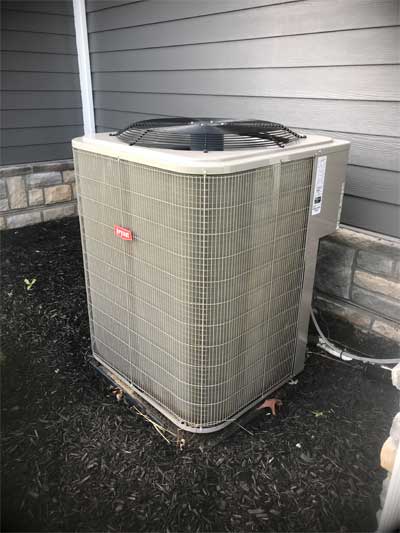
New HVAC unit inspection in Columbus Ohio. Schedule an appointment for a new construction inspection now.
What Are Our Customers Saying?
Find out what our customers are saying about Home Inspection LLC's new construction inspection services throughout Columbus Ohio
Tony was wonderful! Extremely thorough in checking out our future condo. Including suggestions of things we can do to secure safety. Our realtor forgot/didn’t add radon test which we specifically asked for and HC Inspections made sure to revisit prior to our deadline to set up the radon test & get the results to us. Much appreciated!!!
Very polite, professional and thorough! Very knowledgeable and didn't make me feel like any question was too much or too dumb. I would recommend to anyone looking for an inspection for any reason! Greg was my inspector and he did an amazing job and if I ever need this done again, definitely would ask for him!
Greg was meticulous in his work and made sure to explain issues as we went along. He also provided tips for maintaining our appliances as we are first time homebuyers. He went above and beyond to ensure we knew what we were getting into in our purchase!
Very easy process to schedule, and our inspector Greg was amazing. He was able to answer all of our questions and took the time to explain what he was looking for. Overall this was an amazing experience and we would use this service again. the scheduling process was fast, and the inspection was thorough, and the detailed notes after helped make sure nothing was missed.
First time home buyer! We had Matt Brown and he was very professional and kind. He took time to answer all of my questions and explain the reasoning for things. Since he knew it was my first time buying a house, he went out of his way to explain the inspection process, break down the severity of issues we uncovered and provided helpful suggestions on how to go about fixing the issues. Would highly recommend Matt and Home & Commercial Inspections LLC!
Tony did a great job on the inspection for my new condo purchase. His attention to detail was terrific and he took time to explain items to me in detail, including maintenance issues to be aware of in the future. He answered all of my questions and took time to listen to my concerns. Booking the appointment online was a breeze and the report was very thorough and included clear pictures. I would highly recommend them to anyone, especially those new to homeownership.
James was extremely personable, knowledgeable, and very detailed oriented. He took the extra time needed to explain all of the issues to ensure I was aware of exactly what was occurring with my home. He identified several issues and actually saved us from a future leak in our brand new roof!! I would recommend Home & Commercial Inspections 100%.
We requested to work with Greg based on the reviews that we saw and were so glad that we did! He was very responsive via text/phone - on our scheduled day, he showed up early and began inspection right away. His inspection was very thorough and professional. As we walked through the house, he also gave us (as first-time home owners) lots of valuable home maintenance tips. We are recommending Greg and the company to our neighbors and friends, and we will also work with him again for our 11-month warranty inspection!
We were so impressed with James from our previous home inspection a few years ago that we requested him again for our new home. He was great back then and still is now. He’s very thorough and informative and has gone out of his way to our answer questions and provide us additional information. He’s very professional and has a great friendly personality. If we ever need another inspection we’d definitely be calling him again.
Greg did a wonderful job on our home inspection! His inspection was very thorough and detailed. Additionally, he went above and beyond to ensure that we were knowledgeable as first-time home buyers on important aspects of home maintenance. We received our inspection report same day helping us to make a timely decision. He was friendly, personable, and extremely knowledgeable. From the booking to the services rendered, I would strongly recommend this company.
James is the home inspector I wish I had when I bought my place 12 years ago. He is extremely knowledgeable; he clearly loves what he does; he’s very interested and thorough about the structure; no question I had was a dumb question (and I had a lot of those), patiently and carefully answering each in understandable terms; and I learned so much from him. (AND his enthusiasm is kind of contagious.) The helpful report he gave me, which I promptly received a few hours later, was very detailed and full of suggestions -- nothing at all like I’d received from my previous home inspector years ago. On top of that, James is a really nice guy -- friendly, down-to-earth, while staying focused on doing a great job. I would honestly recommend him to anyone.
The inspection was very detailed and the report was made available on the same day as the actual inspection. Mr jones was very helpful and used his high level of expertise and experience to point out things that would have been detrimental to our families health. We found many issues with the home, most of which were not visible at first glance. Moving forward I am thankful that I hired Mr. Jones, and would recomend him to anyone shopping for a home inspection .
I hired James John to inspect two homes and I am very satisfied with his work. He performed his work very professionally. He was able to address any questions during the inspection. He provided the reports in a time manner with a great detail.
Great customer service. They were really personable and did everything to help us out. I'm glad I chose you. I'll recommend to everyone
James Jones made our home inspection process so easy! He is kind and professional and made sure to explain everything that he was doing. James did the inspection on the first home we were in contract on and literally saved us from purchasing a money pit. We trusted his opinion so much that there was no question when we hired him again for an inspection on another home. Thanks, James!
I have used Master Inspector James Jones services at least twice in the past including new home inspection and inspection just before one year warranty expiration . He comes with practitioner experience and expertise and uncovered critical potential defects and did a very thorough inspection. Report was very detailed and all the while during the inspection he was providing the inputs and was explaining clearly along with certain tips. Later he provided very detailed report and responded to follow up questions very quickly. Overall great engaging experience.
Matthew Brown did a fantastic job. His reporting was thorough and educational. He was very professional and knowledgeable. I would highly recommend using their services. They are very affordable.
Mr. Jones was prompt, professional and extremely knowledgeable. He provided a comprehensive home inspection and a detailed report in a timely manner. He welcomed questions during the process, and promptly responded to follow-up questions after the inspection. His certifications and actual work experience in various facets of the housing industry was evident, as he provided knowledge-based observations during the meticulous inspection of our new home. It was money well spent! I'd gladly utilize his services again, and will recommend him to anyone purchasing a new home. You won't go wrong by hiring Home Inspections, LLC; don't let the other guys beat you!
I was beyond impressed with my home inspection! As a 1st time Home buyer I was nervous and unsure about a lot of things. My home inspection was professional and timely. I appreciated the fact my inspector was thorough and took the time to explain things to me. I was so impressed with my experience that I have since referred 2 more people to reach out to him in regards to their inspections. In addition, my realtor was impressed and she took their card and will be suggesting their services for her future clients! THIS WAS BY FAR THE EASIEST PART OF MY ENTIRE BUYING PROCESS!!!!! Awesome job!!!!
Our Home Inspection Service Areas
Home Inspections LLC is proud to serve Columbus, Ohio and surrounding metro areas with our exceptional services! Contact us for home inspections outside of the Columbus metro area.
